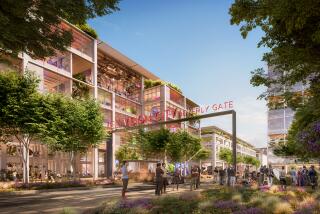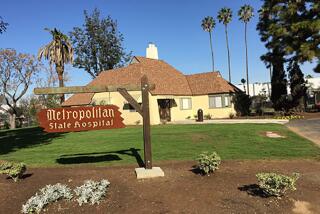Fast-Growing Sylmar Bracing for the Boom From Its New Hospital
- Share via
Sylmar never really got a chance to find out what it’s like to have a major county hospital in its backyard. The first Olive View Medical Center was destroyed on Feb. 9, 1971, just one month after it opened.
At that time, Sylmar was a rural community snuggled against the San Gabriel Mountains. Now it is the fastest-growing community in the City of Los Angeles, with 48,000 residents, housing tracts clinging to the mountainside and condominiums lining Foothill Boulevard.
After the dedication of the rebuilt Olive View on Saturday, the people of Sylmar are bracing themselves--some anxiously and some with elation--for the effects of the hospital’s actual reopening next month.
Business people are getting ready to welcome what they hope will be a throng of new customers. Homeowners are concerned about increased traffic. And horse owners are worried that their free rein on the mountainside, which they have managed to preserve despite development, will come to an end.
“Sylmar used to be known as a sleepy little town, without even a downtown area,” said Robert Rasmussen, a longtime Sylmar businessman and resident. “The hospital opening is going to change all that. We are finally going to be put on the map.”
More than 3,000 people--employees, patients and visitors--will be traveling in and out of Sylmar every day when the hospital is fully operational in 1988. Ambulances, their sirens wailing, will hurry to the hospital and helicopters will land on a nearby helipad, hospital officials said.
Practically every corner on Foothill Boulevard has been purchased for development, said Charlotte Creager, a longtime realtor in the area. The Sylmar Chamber of Commerce says it has received inquiries about opening flower shops, small restaurants, gas stations and dry cleaning establishments.
“They are going to need places to shop, restaurants to eat in, gas stations,” Rasmussen said of the hospital employees and visitors.
First Hotel Due
Sylmar also will soon get its first hotel, with 109 rooms and a large restaurant. Robert Helper of Los Angeles, who is developing the project on the corner of Roxford Street and Foothill Boulevard, said he selected the site because the hospital is a block away and there are no other similar facilities nearby.
All this activity will turn the tranquil Olive View Drive and Roxford Street into thoroughfares, especially in the late afternoon, city transportation officials said.
Traffic is expected to increase to six times its present level, from 200 to 1,200 vehicles an hour at the peak period of 3:15 p.m. to 4:15 p.m. That will still be below the intersection’s capacity of 1,600 vehicles an hour, officials said.
In an effort to reduce short-cutting through residential streets, Foothill Freeway signs will direct drivers to the Roxford Street exit, which leads directly to the hospital.
Concerned About Crime
Some residents also are concerned about crime they think could be generated by the hospital.
“We are bound to be concerned any time you start bringing sick people, mentally ill people, indigent people into the community,” said Hannah Dyke, a community activist who started Olive View Neighborhood Watch, an 800-member homeowner and crime-watch group.
“We welcome the hospital,” Dyke said. “But that doesn’t mean we are going to sit back and let the influx of people change our life style.”
Civic leaders, referring to the concrete foundation and unsightly steel beams that stood in their community for years during the 15-year debate over reconstruction, are pleased that “Sylmar’s earthquake monument” is gone. The new Olive View is the biggest and most modern-looking building in the northeast San Fernando Valley.
Now they are focusing on the issue of how about 135 acres of county-owned land surrounding the hospital will be developed.
Land Sale Important
The land is important to the financially strapped county because its lease or sale for private development could be lucrative. In approving Olive View’s rebuilding, the Los Angeles County Board of Supervisors voted to use the money from the lease or sale of surplus land to finance the hospital’s operations.
The community sees it as a vital piece of real estate because it is the last big, scenic parcel of land left in Sylmar, which has experienced an 11.7% population increase since 1980. The rate is the highest in Los Angeles, according to the city planning department.
Last year the county’s Community Development Commission suggested that part of the land surrounding Olive View be leased to develop a water-slide amusement park, with other parts used for commercial and high-density housing developments.
Community Furor
Opposition in the community prompted county Supervisor Mike Antonovich to reject the water-slide proposal. He said the development plans are “on hold” until residents and the county can see the hospital’s effects.
Antonovich declined to commit himself to any specific type of use for the property, but said he would support “whatever will bring in the most money that will meet with a consensus of the community.”
Predictably, homeowner groups and community leaders are in favor of low-density residential development. City Councilman Howard Finn, who represents the area, supports a similar level of growth.
“Our feeling is that the community should not be sacrificed for a very short-term revenue gain,” said Chuck O’Connell, co-chairman of Hospital Watch, a Sylmar homeowners group.
Concern Over Horses
To the horse owners of Sylmar, a small but vociferous group, the traffic, ambulances, helicopters and hotels would not seem to mix well with horseback riding.
The entrance to one popular horse path, Wilson Canyon Trail, is alongside Olive View. A horse-crossing sign is posted on Olive View Drive.
“We are going to have to push for a horse traffic signal, an underpass or something in front of the hospital,” said Ed Duvall, a horse owner and member of Sylmar Citizens for K-Districting, which refers to horse-keeping property.
But realizing that they would be fighting a losing battle against development, they are concentrating on getting the most they can from mountainside developers, like corral rings and trail heads.
They are hoping their pastoral trails will not go the way of the sprawling olive groves that gave the hospital its name.
According to the county agricultural commissioner’s office, development has shrunk the commercial groves from about 1,600 acres in the late 1950s to fewer than 10.
More to Read
Sign up for Essential California
The most important California stories and recommendations in your inbox every morning.
You may occasionally receive promotional content from the Los Angeles Times.










